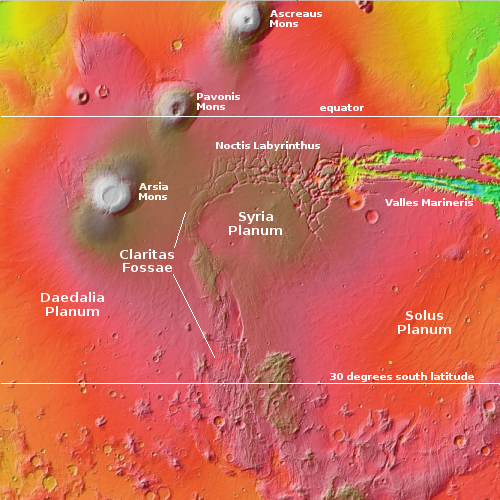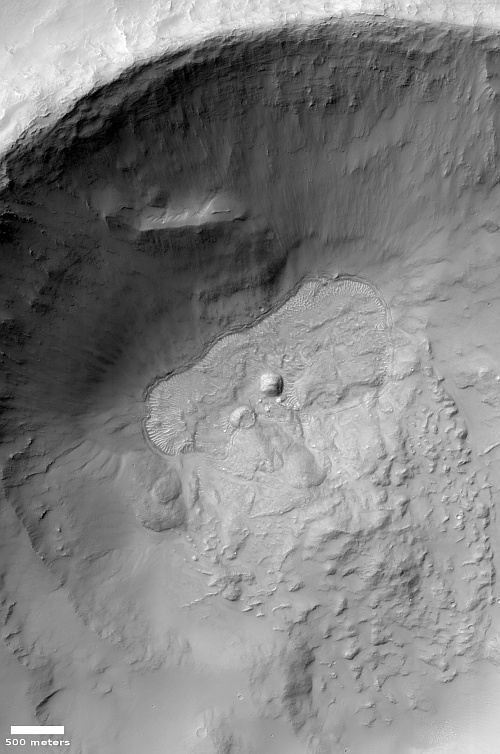Buried dying glacier in the Martian dry equatorial regions?
Today’s cool image from Mars is not so much unique visually as it is unique in terms of its location. The picture to the right, rotated, cropped, reduced, and sharpened to post here, was taken on January 31, 2023 by the high resolution camera on Mars Reconnaissance Orbiter (MRO). It shows the northern rim of a small crater, with its floor filled with an intriguing mound of material.
The picture was labeled a “terrain sample”, which suggests it wasn’t taken as part of any specific research project by instead to fill a gap in the camera’s schedule. To maintain the camera’s proper temperature, it is necessary to take pictures regularly, and when the camera team finds a gap that is too long, they fill it by choosing some almost random target in that gap that might be interesting. Sometimes it is, sometimes not.
In this case I strongly suspect this target was hardly random. The picture title also mentions MRO’s now retired radar CRISM instrument, which was used to detect evidence of underground ice. My guess is that the camera team thus likely decided to image this crater in high resolution because that radar data suggested the presence of underground ice.
This guess is strongly confirmed by a context camera picture taken of this crater on September 1, 2008. The crater appears surrounded by the typical splash apron one routinely sees around impact craters in the mid- and high-latitude northern lowland plains, where there is a lot of near surface ice.
The bumpy mound seen in high resolution on the floor of this crater could very well be buried glacial ice, as it mimics similar features in the many craters in the mid-latitudes of Mars. But is it buried ice? The location says otherwise.

The green dot in the southern part of Solus Planum marks the location of this crater, at 28 degrees south latitude. The location is not only on a vast volcanic flood plain, it is also in the dry equatorial regions where almost no near surface ice has been found.
If the material in the crater floor and the surrounding splash apron suggest near surface underground ice, this location will be one of the closest to the equator yet found. The material itself suggests that if there is any buried ice here, it is ancient and decaying.
It is also possible both the splash apron and the crater floor material is simply evidence of liquid flood lava now hardened in to stone. The impact might have hit the ground soon after that flood lava poured across this plain, when it was still somewhat soft and viscous. The result could thus be the splash apron and features in the crater floor that resemble glacial features.
For these reasons, I am sure a scientist on the MRO’s camera team is looking at this crater with great interest, hoping to solve this question.
On Christmas Eve 1968 three Americans became the first humans to visit another world. What they did to celebrate was unexpected and profound, and will be remembered throughout all human history. Genesis: the Story of Apollo 8, Robert Zimmerman's classic history of humanity's first journey to another world, tells that story, and it is now available as both an ebook and an audiobook, both with a foreword by Valerie Anders and a new introduction by Robert Zimmerman.
The print edition can be purchased at Amazon or from any other book seller. If you want an autographed copy the price is $60 for the hardback and $45 for the paperback, plus $8 shipping for each. Go here for purchasing details. The ebook is available everywhere for $5.99 (before discount) at amazon, or direct from my ebook publisher, ebookit. If you buy it from ebookit you don't support the big tech companies and the author gets a bigger cut much sooner.
The audiobook is also available at all these vendors, and is also free with a 30-day trial membership to Audible.
"Not simply about one mission, [Genesis] is also the history of America's quest for the moon... Zimmerman has done a masterful job of tying disparate events together into a solid account of one of America's greatest human triumphs."--San Antonio Express-News
Today’s cool image from Mars is not so much unique visually as it is unique in terms of its location. The picture to the right, rotated, cropped, reduced, and sharpened to post here, was taken on January 31, 2023 by the high resolution camera on Mars Reconnaissance Orbiter (MRO). It shows the northern rim of a small crater, with its floor filled with an intriguing mound of material.
The picture was labeled a “terrain sample”, which suggests it wasn’t taken as part of any specific research project by instead to fill a gap in the camera’s schedule. To maintain the camera’s proper temperature, it is necessary to take pictures regularly, and when the camera team finds a gap that is too long, they fill it by choosing some almost random target in that gap that might be interesting. Sometimes it is, sometimes not.
In this case I strongly suspect this target was hardly random. The picture title also mentions MRO’s now retired radar CRISM instrument, which was used to detect evidence of underground ice. My guess is that the camera team thus likely decided to image this crater in high resolution because that radar data suggested the presence of underground ice.
This guess is strongly confirmed by a context camera picture taken of this crater on September 1, 2008. The crater appears surrounded by the typical splash apron one routinely sees around impact craters in the mid- and high-latitude northern lowland plains, where there is a lot of near surface ice.
The bumpy mound seen in high resolution on the floor of this crater could very well be buried glacial ice, as it mimics similar features in the many craters in the mid-latitudes of Mars. But is it buried ice? The location says otherwise.

The green dot in the southern part of Solus Planum marks the location of this crater, at 28 degrees south latitude. The location is not only on a vast volcanic flood plain, it is also in the dry equatorial regions where almost no near surface ice has been found.
If the material in the crater floor and the surrounding splash apron suggest near surface underground ice, this location will be one of the closest to the equator yet found. The material itself suggests that if there is any buried ice here, it is ancient and decaying.
It is also possible both the splash apron and the crater floor material is simply evidence of liquid flood lava now hardened in to stone. The impact might have hit the ground soon after that flood lava poured across this plain, when it was still somewhat soft and viscous. The result could thus be the splash apron and features in the crater floor that resemble glacial features.
For these reasons, I am sure a scientist on the MRO’s camera team is looking at this crater with great interest, hoping to solve this question.
On Christmas Eve 1968 three Americans became the first humans to visit another world. What they did to celebrate was unexpected and profound, and will be remembered throughout all human history. Genesis: the Story of Apollo 8, Robert Zimmerman's classic history of humanity's first journey to another world, tells that story, and it is now available as both an ebook and an audiobook, both with a foreword by Valerie Anders and a new introduction by Robert Zimmerman.
The print edition can be purchased at Amazon or from any other book seller. If you want an autographed copy the price is $60 for the hardback and $45 for the paperback, plus $8 shipping for each. Go here for purchasing details. The ebook is available everywhere for $5.99 (before discount) at amazon, or direct from my ebook publisher, ebookit. If you buy it from ebookit you don't support the big tech companies and the author gets a bigger cut much sooner.
The audiobook is also available at all these vendors, and is also free with a 30-day trial membership to Audible.
"Not simply about one mission, [Genesis] is also the history of America's quest for the moon... Zimmerman has done a masterful job of tying disparate events together into a solid account of one of America's greatest human triumphs."--San Antonio Express-News



The walls have riblets in them consistent with lava (where A fluid, if not too viscous, would erode creating trenches)
The mass that appears to be ice has a border around it consistent with contraction… Lava does not do this? (Mars is strange)
The square and round boulder at the top of the glacier mass stands out in comparison with the rest of the picture.
They are out of place. unique in size and composition.
There appears to be a “cave opening” in the dark shaded area at the bottom of the glacier mass. It’s in the shape of a lipless mouth, but then it could be just a shadow?
It’s position suggest the source of the darkened material.